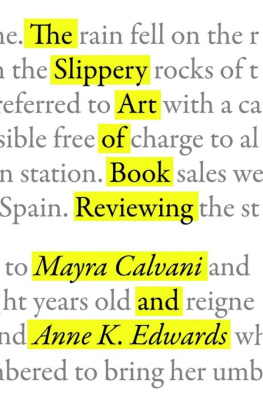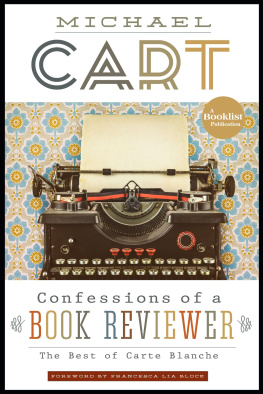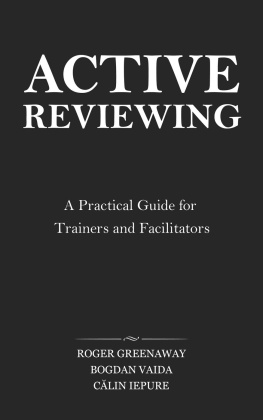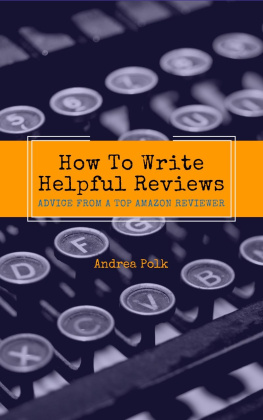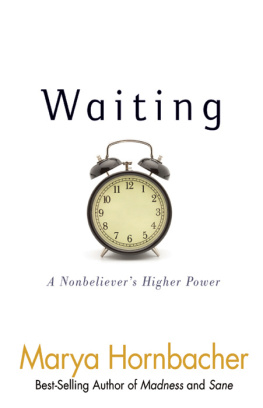The Slippery Art
of Book Reviewing
By Mayra Calvani and
Anne K. Edwards
Twilight Times Books
Kingsport Tennessee
The Slippery Art of Book Reviewing
Copyright 2008 by Mayra Calvani and Mary L. Emmons
All rights reserved. No part of this book may be reproduced, stored in a retrieval system or transmitted in any form by any means electronic, mechanical, photocopying, recording or otherwise, except brief extracts for the purpose of review, without the permission of the publisher and copyright owners.
Twilight Times Books
P O Box 3340
Kingsport, TN 37664
http://twilighttimesbooks.com/
First Edition, June 2008
Revised June 2010
Cover art by Kurt Ozinga
Electronically published in the United States of America
Table of Contents
Foreword by James A. Cox
When I began reviewing books for a small community sponsored public radio station in Madison, Wisconsin in the fall of 1976, providing literary critiques of published literature was largely the prerogative of an ivory tower elite primarily concentrated among the literati of New York City along with a few Ivory League bastions such as Boston and Philadelphia.
It was a time when publishing was dominated by the large New York publishing houses, with subsidized academic presses serving primarily as means for academics to secure tenure.
I began with an Underwood manual typewriter, a Rolodex of contact information for sixty of the largest publishing firms in the country, and some letterhead stationary with Madison Review of Books in the masthead.
At the same time, I began to supervise volunteers and adding their reviews to our weekly half-hour broadcasts, as well as corresponding with publishing house publicity and marketing departments providing them with copies of the reviews and soliciting new submissions.
In 1978 an additional platform was added to provide opportunities for the increasing number of reviewers and their reviews with the first weekly cable television show in Madison which I produced, hosted and aptly named Bookwatch. It was to run for 21 years with the final program airing in December of 2001.
In 1980, because of our expanded geographic networks of reviewers and audiences, the Madison Review of Books was renamed the Midwest Book Review, with the first of what was to become nine monthly book review newsletters and magazines being launched.
Along the way additional platforms and forums for reviews were added including a short-wave radio broadcast that beamed reviews to all of the countries of the world. Our reviews became staples of such online book review databases as alt.bookreviews.com, Amazon.com, Lexus-Nexus, Goliath, and Book Review Index. The Midwest Book Review website was created for authors, publishers, librarians, booksellers, and the general reading public becoming one of the largest and most respected of such sites in the publishing industry.
I began early on to give workshops and seminars on book reviewing and the setting up of book review organizations. Was the frequent subject of interviews with authors writing how to books on writing, publishing for a book reviewers perspective. With the advent of the Internet I often became an interviewed guest for podcasts when the subject of reviewing books was on the agenda.
Now in its third year, I also write a monthly column of commentary and advice for writers and publishers called the Jim Cox Report.
This is basically how I came to acquire something of an expertise in reviewing books on a professional level and in a multiplicity of venues, forums, and formats. Ive had the honor and responsibility for supervising, editing, and educating hundreds of people in the art, craft, and science of reviewing books.
Just as it is the mission of the Midwest Book Review to promote literacy, library usage, and small press publishing, I feel that it is the obligation of book reviewers, be they amateurs or professionals, to encourage with their reviews and critiques writers to write better, publishers to publish more effectively, and readers to read with greater satisfaction.
Toward these ends I wholeheartedly recommend that anyone who aspires to reviewing books effectively and responsibly needs to master the information, apply the advice, read carefully the recommendations, and take advantage of the resources to be found in Mayra Calvani and Anne K. Edwards superbly organized and thoroughly user friendly instruction manual The Slippery Art of Book Reviewing.
There is far more to competently reviewing a work of fiction or a book of non-fiction than what we all remember from the turning out of book reports in our school days. The Slippery Art of Book Reviewing covers all the aspects of this detailed process providing not only the rules of the road for reviewing books, but the reasoning behind those rules as well.
Also covered in depth is a practical approach to the nuts and bolts of operating a book review organization, publication, or website.
The three major problems that are commonplace among book reviewers is that of egregiously imposing their own egos upon their assessments of what they are reviewing; lacking an appropriate and consistent structure with respect to their workload; and failing to communicate effectively with the publishing community.
The first of these weaknesses is self-evident to us all. Reviewers who are reviewing the book they think should have been written instead of the one that was. Of preferring a well-crafted and malicious put-down to an honest but non-malicious critique of a books weaknesses and strengths. Of failing to support their opinions with cited and exampled reasoning.
The second of these flaws emerges with such symptoms as failing to meet deadlines, becoming overwhelmed by the numbers of titles clamoring for attention, falling into the use of hack formulas rather than customized critiques.
The third of these problems is reflected by the absence of professional quality letterhead stationary; a failure to notify publishers of the reviews and to provide them with a copy of the review; and a chronic lack of accessibility or responsiveness to authors and publishers with respect to the status of their book submissions.
The cure for these commonly encountered book reviewer defects is simple and straight forward.
1. Write with a professional and justified detachment on the merits and demerits of the book within the framework of expectations focused upon the authors intended readership.
2. Treat book reviewing as the professional activity it should be, complete with daily, weekly, monthly schedules and project calendars; as well as dealing with solicited and unsolicited incoming titles submissions according to a coherent initial screening process, status inquiry response system, assignment tracking system, and realistic deadline schedule.
3. Always provide the authors, publishers, or publicists who submit review copies with a copy of the review along with a notification cover letter on professional letterhead stationary explaining where the review has been published or posted or broadcast.
In the end, the way to become an effective and respected book reviewer is the same process that professional musicians must apply to the mastery of their chosen instruments practice, practice, practice.
One last piece of advice based upon decades of personal experience. If the reading of books has been your favored hobby and you seek to make your living (or some substantial portion of it) from reviewing what you read then it is time for you to get a new hobby!
As for all of you who aspire to review books and to have your reviews made available to the widest possible readership I have only one final recommendation.
Read very carefully the following pages that comprise The Slippery Art of Book Reviewing and keep it close by for future reference.
Next page
